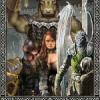Just think about it for a minute, from a purely logical point of view, ignoring D&D game rules and whatnot.
What you're describing would mean that there are exactly the same number of people with 3 or 18 strength as there are with 10. One answer to this: no  .
.
(Edited because I got a little bit too snarky.)
No I'm not. What I'm pointing out is that a 3d6 distribution is approximately normal and certainly symmetric, with the lower quatrile around 8, and the upper quatrile around 13.
Or better yet, just read my post in which I generated those statistics. 12% of the population will have a STR of 10. 0.5% will have an STR of 18, and 0.5% will have an STR of 3. (More or less. 5 out of 1,000 is easier to remember than 4.something out of 1,000.)
The vast majority of people are not born overly weak or overly strong, they're born with an average strength. Of course there are people born naturally strong or naturally weak, but it's pretty much the same number of people for both.
Actually, the majority of people are born with 1 STR in
D&D terms. The 3d6 rule for ability scores assumes that we are talking about adults. There are in fact modifiers within the
D&D rules for youth and age. (Strength and Constitution take hits while Intelligence and Wisdom increase.)
Anyway, lets fast forward everyone to adulthood. Some people will start tobecome stronger through a physically demanding job, exercise, or whatever. Those who have a job with low physical requirements and don't exercise much would not begin to lose strength, it would just stay as it is naturally.
Not true. With strength especially it is a matter of use it or loose it. (The same is true with dexterity and intelligence to lesser degrees.) But why is it hard to fathom that 25% of a population can't deadlift more than 90lbs without assistance? 6-7 strength (55lbs max lift) is not that horrible in real-life terms.
So there will be many more people with higher than average strength than there are with lower than average strength - this fits well with the mode, but not the mean.
No-one ever said the majority of humans have above average strength - (that would make the average higher, meaning they no longer had above average strength . However as I said above, in terms of the mode, more humans would have above average strength than below average strength.
Contradicting yourself in the same post?
The mode is pretty flawed as a measurement of central tendency which is why it is not taken seriously except for categorical data. If you are going to talk about the average, the only two meaningful definitions here are the mean, or the median. The median is slightly better than the mean for this particular case, which is why I'm using quatriles rather than standard deviations to describe variance.
Edited by kirkjobsluder, 31 July 2004 - 05:24 PM.















